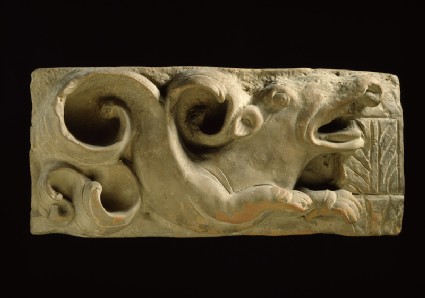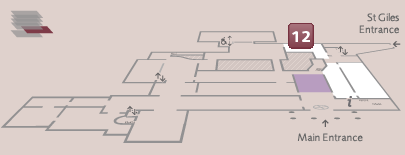Browse: 61 objects
- Reference URL
Actions
Plaque with a makara, or aquatic monster
-
Description
The makara is an auspicious aquatic monster, symbolizing water and fertility. It is shown with gaping jaws and protruding forefeet, while its tail becomes transformed into curling vegetal scrolls typical of Gupta art. This vigorously modelled relief formed part of a frieze from a temple.
-
Details
- Associated place
-
Asia › India › north India › Uttar Pradesh › Mathura district (place of creation)
- Date
-
2nd half of the 4th century - 1st half of the 5th century AD
Gupta Period (AD 320 - 600)
- Material and technique
- terracotta
- Dimensions
- 19.7 x 43 x 11 cm max. (height x width x depth)
- Material index
- Technique index
- Object type index
-
sculpture › relief › temple-relief,
- No. of items
- 1
- Credit line
- Purchased, 1971.
- Accession no.
- EA1971.13
-
Further reading
Harle, J. C., and Andrew Topsfield, Indian Art in the Ashmolean Museum (Oxford: Ashmolean Museum, 1987), no. 26 on p. 20, pp. xiv, 6-7, 11, & 22, illus. p. 20
Harle, J. C., Gupta Sculpture: Indian sculpture of the Fourth to the Sixth Centuries A.D. (Oxford: Clarendon Press, 1974), fig.148
London: Hayward Gallery, 25 March-13 June 1982, In the Image of Man: The Indian Perception of the Universe through 2000 Years of Painting and Sculpture, George Michell, Catherine Lampert, and Tristram Holland, eds (London: Arts Council of Great Britain, 1982), no. 32
London: Asia House Gallery, Autumn 1978, The Ideal Image: The Gupta Sculptural Tradition and its Influence, Pratapaditya Pal, ed. (New York: Asia Society in association with J. Weatherhill, 1978), no. 33
Ahuja, Naman, ‘Early Indian Art at the Ashmolean Museum - Catalogue in progress’, 2016, no. 118
Location
Objects are sometimes moved to a different location. Our object location data is usually updated on a monthly basis. Contact the Jameel Study Centre if you are planning to visit the museum to see a particular object on display, or would like to arrange an appointment to see an object in our reserve collections.
Galleries
Publications online
-

Indian Art in the Ashmolean Museum
The makara, a half-aquatic monster, is perhaps the most frequent depicted fabulous animals in Indian art. This relief formed part of a frieze on one of the innumerable brick temples, of which only a handful have survived, built during and after the Gupta period in northern India. Not only were the niches filled with large, nearly life-sized reliefs of the principal deities, but the upper storeys were thronged with figures, some fanciful like this one, some even humorous, amidst the moulded brick architectural motifs.
Brio is one of the characteristics of the larger Gupta terracottas such as this one. Modelled with great freedom, the artist has managed to convey in clay the aquatic, almost slimy, texture of the beast’s paws and snout; whereas the rear portion transforms itself, without the slightest awkwardness in the transition, into the great curling vegetal scrolls which are one of the glories of Gupta sculpture, both in stone and terracotta. The high relief and “lateral” cutting are one of the hallmarks of the style at its pinnacle.
© 2013 University of Oxford - Ashmolean Museum



